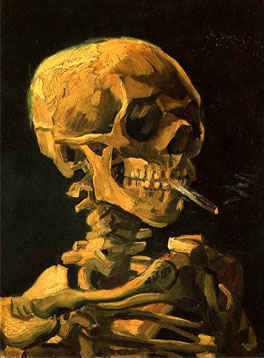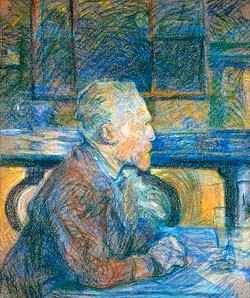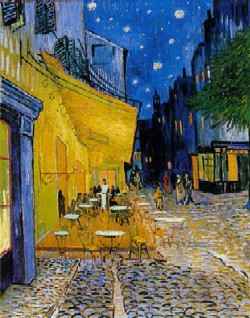|
Vincent van Gogh Vincent van Gogh once said, "An artist needn't be a clergyman or a churchwarden, but he certainly must have a warm heart for his fellow men."
Vincent van Gogh once said, "An artist needn't be a clergyman or a churchwarden, but he certainly must have a warm heart for his fellow men."Van Gogh might be better known for his bloody ear than his warm heart, but you gotta love the sentiment. Young Vincent was doomed from the start. He was born a year to the day after a stillborn fetus, also coincidentally named "Vincent." Now, 150 years ago, people were considerably less sensitive to such things than they are today, and the art of psychology was only in its infancy. Nevertheless, it's not real hard to see how issues could arise from this state of affairs. Certainly, Vinnie had no shortage of issues. After a religious education and a brief stint at boarding school, young van Gogh dropped out for reasons which remain unknown. Vincent was notable during this time for a complete absence of interest in art. When Vincent left school, however, art became a central part of his life... in the same way that Big Macs become a central part of many teenagers' lives today. van Gogh took a job selling art for a Netherlands dealer. After a few years working near home, van Gogh was transferred to London and never looked back. "Those Dutchmen had hardly any imagination or fantasy, but their good taste and their scientific knowledge of composition were enormous," he wrote.
Although van Gogh had always displayed depressive tendencies, it was only after this incident—and others like it—that he began to seem out of control. His lack of success with the ladies depressed him, and may have exacerbated some deeper problems that had been there all along. When van Gogh started harassing the customers at the art dealership, his employer tried transferring him to Paris to get his mind off the failed romances he'd experienced in Britain. When that didn't work, he fired young Vincent. At age 23, Vincent still entertained no thoughts of being a painter. Finding himself unemployed, he turned to God for help. van Gogh took a job as a minister. If his encounters with women had touched off a deep chord of dysfunction in van Gogh, his encounters with God would seal the deal. van Gogh had the sort of relationship with God that only a paranoid schizophrenic can really appreciate. Vincent wandered Europe studying religion and looking for paying work. His grooming declined sharply, while his scary-craziness increased dramatically. He began living a life of extreme asceticism, which didn't work out so well. He tried preaching to village audiences, who found him incomprehensible. Finally, at age 27, he gave up on religion and turned to painting for the first time. Despite this late start, the good news was that Vincent had finally found a trade in which he truly excelled. The bad news was that he was just enough ahead of his time to ensure a live of struggle and poverty.
"If I were to think of and dwell on disastrous possibilities, I could do nothing," he wrote. "I throw myself headlong into my work, and come up again with my studies; if the storm within gets too loud, I take a glass too much to stun myself." The glass in question was often absinthe. Fellow painter Toulouse Latrec painted a portrait of van Gogh sitting with his glass of absinthe. van Gogh himself immortalized the drink in his own work.
Because, you see, there's no reason van Gogh could possibly have wanted to paint the things he did without some biochemical explanation. Art, as we all know, is primarily chemistry. And don't forget that any pleasant sensations you experience while looking at art are also just chemistry. In fact, you're just having a hypoglycemic episode or a mild seizure. Art is inherently meaningless, God is dead, we're all just robots, kill yourself now. Anyway, back to van Gogh. Even without a bunch of bored biochemists to depress him, Vincent was having troubles. Since he too much of a buffoon to understand the subtle effects of neurotoxins on his brain, he ridiculously attributed these troubles to his continuing string of spectacular failures in the romance department. van Gogh fell in love with his cousin, who spurned him mercilessly. He tried to burn himself with an oil lamp to demonstrate his love for the woman, but her father blew out the lamp, spoiling the moment. Finally, van Gogh found the right woman for him—a prostitute. He managed to eke out nearly two years of domesticity with "Sien," who moved in with him and brought along her two children by other men. (Oh, by the way, love? Just chemistry.) At the end of the relationship, van Gogh was emotionally devastated but hitting his artistic peak.
Unfortunately, his artistic success did not correspond with commercial success. Vincent was painting, but no one was buying. His brother Theo underwrote his work, barely, but even their relationship was growing strained. With virtually every other aspect of his life in the toilet, van Gogh now started doing the best work of his career, paintings with titles like "Skull with Burning Cigarette" and "The Potato Eaters," a grim and condescending portrait of peasantry that nevertheless showed the first glimmerings of his real talent. After a period of several months wandering the continent with his paints, van Gogh settled in France, first staying in Paris and later moving to the countryside. As his physical health faltered (due in part to spending his money on art supplies instead of food), his work continued to improve by leaps and bounds. He spent time with Paul Gaugin, whose paintings were modestly successful, making him infinitely more successful than van Gogh himself.
Gaugin and van Gogh were roommates for a couple of months, but they argued about art and found domestic bliss elusive. The tension between the two set the stage for van Gogh's most infamous accomplishment, known even to those who couldn't identify one of his paintings out of a lineup of Picassos. Vincent had never been particularly stable, and Gaugin was no day at the beach himself. After the two had a violent argument just before Christmas of 1888, Gaugin left town and van Gogh broke down. His established mental eccentricities aggravated by a combination of alcohol, absinthe, and epilepsy, van Gogh began hearing things. With the cold, unrelenting logic of the insane, he deduced that the solution to the problem was to cut off his left ear. In reality, it was only the lower lobe of his ear, but it was a fairly extreme statement nevertheless. He attempted to give the now-detached organ to a prostitute, insisting it was a priceless gift. This didn't go over very well, and the artist was hospitalized. The blood loss and infection nearly killed him, but he recovered. He emerged from the hospital seemingly in better spirits, but broke down again in just a few weeks, claiming that someone was trying to poison him. van Gogh spent the next several weeks in and out of the hospital, until his brother finally convinced him to enter an asylum. The scientific treatment for mental illness was to leave patients soaking in a tub for hours at a time.
Unfortunately for his art, he tried eat his paints in an apparent suicide attempt, which was the end of his painting privileges for a while. The pattern of recovery and relapse continued for almost two years, in and out of the asylum, and eventually in Paris, where he traveled to stay with his brother. Painting at every opportunity he didn't feel compelled to poison himself, van Gogh continued to struggle with bouts of paranoia and delusions, with a continuing impact on his physical health. On July 27, 1890, van Gogh finally figured out that a tube of oil paints wasn't going to do the trick. While out painting in a wheat field, he shot himself in the chest with a revolver. Once again, he failed to do himself in, and he managed to walk home to the inn where he had been staying, before collapsing into bed without telling anyone what had happened. When the innkeeper found him in a pool of his own blood, he called a doctor and van Gogh's brother, Theo. The bullet was too close to his heart to be removed, and van Gogh suffered another seizure. With his wounds, the impact was too much. After telling his brother, "the sadness will last forever," he finally died, two days after launching the attempt. He was denied a funeral because he had committed suicide.
|
 In London, it appears, he had his first romantic entanglements, which went poorly. He proposed to a woman who was already engaged to someone else, an uphill battle which he didn't win.
In London, it appears, he had his first romantic entanglements, which went poorly. He proposed to a woman who was already engaged to someone else, an uphill battle which he didn't win.  He continued to wander Europe, only this time studying art instead of religion. He found solace for his battered mind in his work—and other less productive pursuits.
He continued to wander Europe, only this time studying art instead of religion. He found solace for his battered mind in his work—and other less productive pursuits.  It's particularly fashionable in medical circles these days to write endlessly about how the effects of absinthe and other commonly abused drugs of the day might have shaped van Gogh's art, for instance by causing him to hallucinate the halos and aurorae that often surround light sources in his paintings.
It's particularly fashionable in medical circles these days to write endlessly about how the effects of absinthe and other commonly abused drugs of the day might have shaped van Gogh's art, for instance by causing him to hallucinate the halos and aurorae that often surround light sources in his paintings. "Painting and fucking a lot are not compatible; it weakens the brain," he wrote. In the absence of his dysfunctional little family, he hit the road with his paints and canvases.
"Painting and fucking a lot are not compatible; it weakens the brain," he wrote. In the absence of his dysfunctional little family, he hit the road with his paints and canvases.  Although his work was beginning to impress and influence fellow artists like Gaugin, van Gogh was still unable to sell his work. Poor and increasingly alcoholic, his health began to deteriorate again. It was during this period that he created some of his most enduring works, including "Sunflowers" and "Pavement Cafe at Night."
Although his work was beginning to impress and influence fellow artists like Gaugin, van Gogh was still unable to sell his work. Poor and increasingly alcoholic, his health began to deteriorate again. It was during this period that he created some of his most enduring works, including "Sunflowers" and "Pavement Cafe at Night."  The treatment rendered him soggy, but not appreciably more sane. The asylum allowed him to paint, and within its walls he created perhaps his most powerful work, "Starry Night." He once wrote to his brother, "I often think that the night is more alive and more richly colored than the day," a sentiment amply reflected in his most famous work.
The treatment rendered him soggy, but not appreciably more sane. The asylum allowed him to paint, and within its walls he created perhaps his most powerful work, "Starry Night." He once wrote to his brother, "I often think that the night is more alive and more richly colored than the day," a sentiment amply reflected in his most famous work.